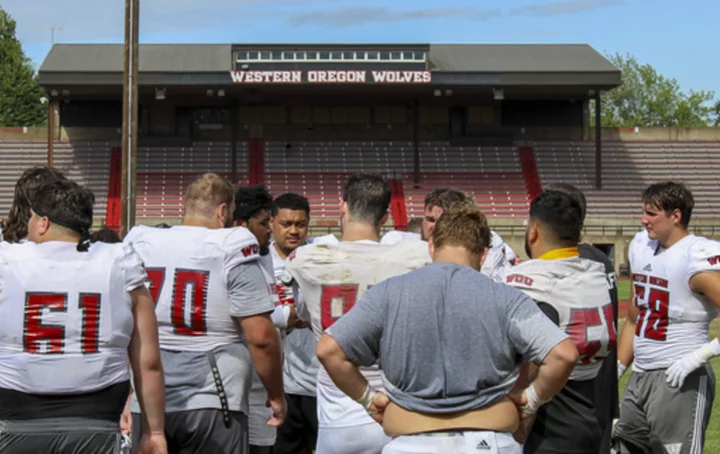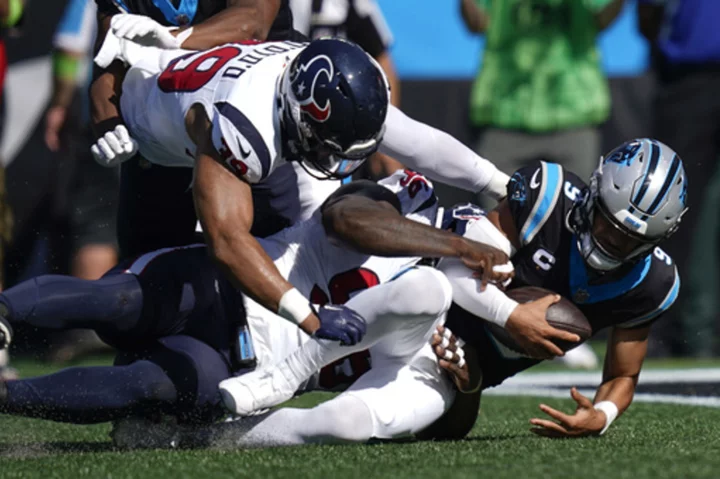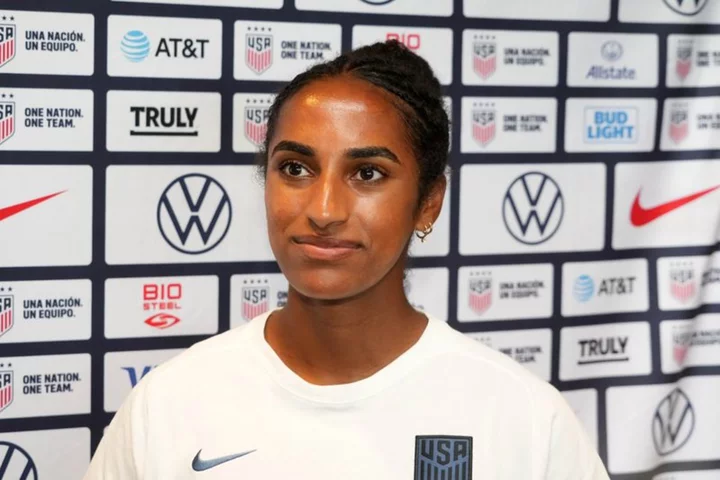MONMOUTH, Ore. (AP) — When Arne Ferguson started as an assistant coach at Western Oregon in 1989, road games meant bus trips. Sometimes a few hours to schools in Washington. Sometimes just a few minutes up the road to Oregon towns like Salem, Forest Grove and McMinnville.
All on the bus and neatly contained inside the Pacific Northwest.
Now entering his 18th year as the head coach, those bus days are long gone. Ferguson and his team are frequent flyers as one of only two NCAA Division II programs remaining on the West Coast.
During this upcoming season, the Wolves will fly six times. They will play non-conference games in South Dakota and Minnesota, and play league games in Texas and New Mexico.
It’s a massive undertaking, financially and logistically. It requires 3 a.m. wakeup calls on Fridays, followed by buses to the airport, four-hour commercial flights, Saturday games and doing it all in reverse on Sundays.
There will be more than 160 programs in the country playing football at the Division II level this season and only two of them — Western Oregon and Central Washington — are in an area of more than 68 million people. There are no D-II football programs in California, Nevada, Idaho, Montana, Utah, Wyoming or Montana.
“That’s the biggest challenge, financially, but it’s also a really great opportunity for our department and our university because we’re very visible on the entire West Coast and down into Texas,” Western Oregon athletic director Randi Lydum said. “I try to tell people that we’re like walking billboards when you see a football team walking through an airport and they’re all wearing their Western Oregon University gear.”
Western Oregon and Central Washington are affiliate members of the Lone Star Conference for football – opponent schools are in Texas and New Mexico -- while their other athletic programs play closer to home in the Great Northwest Athletic Conference.
Division III and NAIA programs remain strong in the West. But at Division II there is a concerning void. A progressive disappearance of programs spanning 30 years has created challenging travel decisions and raised questions of whether it’s worth the investment.
“(The players) wouldn’t know what it would be like to hop on a bus and drive a few hours to some of these closer locations. It’s just kind of life as we go here,” Central Washington coach Chris Fisk said. “But I think it’s a positive, the move to the Lone Star Conference, and even though it comes with that travel, and the kids don’t worry about the budget ... but it’s just kind of what we need to do to be able to compete and play really good teams.”
Ferguson, for one, seems determined that Western Oregon plugs ahead. He played for the Wolves in the mid-1980s, returned as an assistant and outside of one year as a high school coach, has been associated with Western Oregon for more than 30 years.
He has seen the evolution of the program, located about 65 miles southwest of Portland in a town of about 11,000 residents. During Ferguson's time, Western Oregon has gone from an NAIA program competing with public and private schools in the Pacific Northwest to the current state of jet-setting to find games.
His primary concern is about the opportunities lost with cuts elsewhere. During training camp, Ferguson had 138 players on the field. For a school with a total enrollment of less than 4,000, that's a notable percentage of the total student body.
“We’ve had kids that come in here and didn’t think they were going to play and all of a sudden they’re a starter (and) all-league. We’ve seen them come through here and all of a sudden they’re a doctor,” Ferguson said. “And providing that opportunity and that platform for them to just to put their head down and work, and be good people and learn how to grow up and be successful that’s what we’re proud of.”
It didn’t used to be this way. Into the 1990s, there was a healthy number of programs along the West Coast before several California schools including Chico State, Cal State East Bay, Sonoma State and San Francisco State dropped football. Another domino fell in 2009 when Western Washington eliminated its program.
Central Washington and Western Oregon moved to the Lone Star after Cal Poly Humboldt and Azusa Pacific dropped football within the past five years. The region took another hit this past spring when Simon Fraser, the lone Canadian member of the NCAA, said its football program was folding.
The two remaining programs now pull in players from all over the region. Western Oregon’s roster last season represented Oregon, Washington, Idaho, California, Hawaii, Nevada, Texas and Kansas.
“We get to represent a larger portion,” Western Oregon quarterback Gannon Winker said. “So at Western Oregon we represent a lot of California, Washington, Oregon and now even more so we’re getting into Texas and we get to bring kids from all over the country to a place that they might not have ever seen before.”
As usual, money plays a role. The revenue streams that garner headlines at the FBS level and led to the recent run of conference realignment are foreign ideas for the smaller schools. A big chunk of Western Oregon’s athletic budget comes from the Oregon Lottery. There are scholarships but rarely is a player on a full ride.
Division II allows a maximum of 36 scholarships in football — often shared across an entire team. Central Washington has 28 or 29 fully funded scholarships; Western Oregon has 13 or 14.
“There are thousands of kids on the West Coast that don’t get that opportunity to go play at the next level,” Fisk said.
While Division II football thrives in the Midwest and parts of the East, it has struggled to gain broad attention in the West. Utah Tech – formerly Dixie State – used to regularly play Western Oregon and Central Washington and spent time in the Rocky Mountain Athletic Conference before beginning the transition to the FCS level in 2020.
“There isn’t any appetite for Division II athletics in the state of Utah or the surrounding area. There’s just not. People can’t even tell you about Division II programs,” Utah Tech athletic director Ken Beazer said. “Now in the Midwest or back East, Division II, I think, has some street cred. I think it has some viability and some equity. Out here, it does not athletically. And we found that out.”
The transition isn’t quick. Utah Tech officials believe it’s a 10-year process before their revenues and infrastructure are at the point of many of the top FCS programs.
Central Washington regularly hears questions about FCS with fans seeing the Big Sky Conference as an option. But it’s not a football-only decision and moving up would likely mean an additional $10 million per year needed for the entire athletic department.
“A lot of people come and talk to me all the time about it and I say this isn’t money they have to raise once. This is money you have to have every year. And you have to increase that,” Central Washington athletic director Dennis Francois said.
This season, both Central Washington and Western Oregon have football travel budgets topping $400,000. When Francois first arrived at Central Washington 10 years ago, the entire football operations budget – including travel – was $300,000.
Because of those costs, guarantee games with FCS teams are a must. One of Western Oregon’s flights is the season opener at South Dakota State, the defending FCS national champions. While not a big payday, it should provide enough money to offset one of the plane trips later in the season.
For now, both schools seem set on making the situation work as long as possible.
“I am biased but I love student athletes and I love our football student athletes,” Lydum said. “They just bring an energy and just excitement to our campus that I think if we didn’t have it would just be sorely missed.”
___
AP college football: https://apnews.com/hub/college-football and https://apnews.com/hub/ap-top-25-college-football-poll









